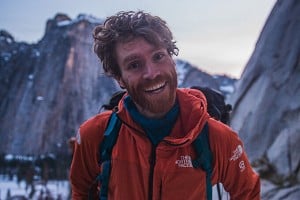
“From Across The Pond” is a regular feature of ukclimbing.com written by ex-pat Mick Ryan from Saratoga Springs in upstate New York. Mick is a cofounder of Rockfax guidebooks and for the last eight years helped put the bouldering Mecca of California's Bishop and Eastern Sierra on the global climbing map.
His last piece of writing for ukclimbing was a review of Simon Panton's North Wales bouldering guide. This review was described by Mark Stevenson as "probably the best article I've read online this summer. It's a real shame that reading prose of that quality is an increasingly rare online experience."
You can write to the letters department of “From Across The Pond” with your comments and questions via email - fatp@ukclimbing.com
Headpointing, Boltpointing, Urban Climbing and Kansas Rock
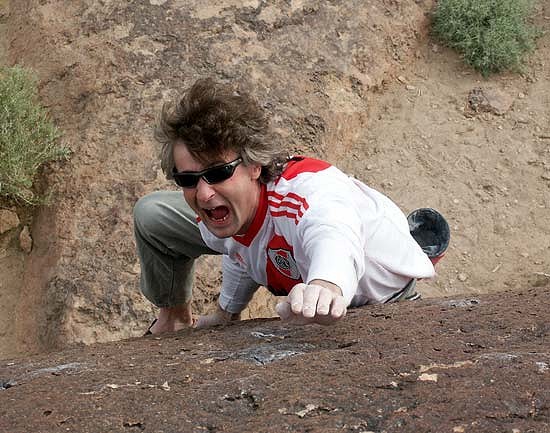
There are other reasons given as to why Brits have embraced headpointing including the fact that our open-ended E-grading system rewards those who climb hard and that the incestuous (close geographical) nature of British climbing breeds competition.
Headpointing hasn't exactly taken the US by storm but it is definitely taking hold. The film Hard Grit was very influential in this movement as was the increase in the popularity of bouldering and the blurring of the line between a boulder problem and a route. Highball bouldering is becoming quite popular in the US; witness Jason Kehl's headpoint of Evilution a 5.13R up the Grandma Peabody (a very tall boulder) in Bishop; his headpoint of Jerry Moffat's top-rope problem After Midnight on the Columbia Boulder in Yosemite's Camp 4; and his headpoint-bouldered ascent of the sport route The Fly 5.14d/V13 with a lots of pads.
Recent headline headpoint milestones include ex-pat Andy Donson's ascent of The Lion 5.12b X in Eldorado Springs Canyon, Colorado and Eric Decaria's ascent of Must'A Been High 5.13c R in the same canyon. In New England, long a bastion of English-style ethics due in part to it being the home of the ethicist Henry Barber, Tim Kemple headpointed Bamboozled 5.13a/b R at Cathedral Ledge. Even some 40-somethings are getting in on the act when Mark Richey and Everest summiteer Barry Rugo headpointed Dune 5.12d R at Crow Hill in western Massachusetts.
From Squamish in Canada to North Carolina to Minnesota, headpoint ascents are hitting the magazine headlines. Strangely perhaps, the US's most competent ex-pat headpointers, Dave Pegg and Kevin Thaw, have been quiet on the US heapointing front.

“Most of the rock where I live is limestone. Bolts are allowed, the good hard lines are too steep to top-rope and even after cleaning holds can still break. I think the style has to suit the area. Headpointing here would be silly. Plus the older I get the more of a coward I become. I'm much more aware of how much there is to lose. I have a lot of things that I didn't have when I was 20, like a home and a wife. Today, instead of scaring myself silly, I get my kicks out of exploring the physical side of the sport seeing how hard I can pull with a big, fat bolt at my waist. Headpointing is something I've grown out of.”
Kevin Thaw, international man of mystery and sometime resident of Bishop, California, Buenos Aires and Saddleworth, has climbed a new 1300m alpine rock route on a new Patagonian summit (The Thaw's not Houlding Wright V 5.10. Cerro Pereyra) a new sport route at Los Mogotes near Cordoba, dozens of new boulder problems, a headpoint Sectioned (E8) at his beloved Wimberry in the Peak, and all in 2004, but has stayed away from headpoint ascents in the US. Why?
“There is no headpointing in the US. Gritstone's height lends to the style and frankly US rock is often shoddy. Tall cliffs would require elaborate rigging and don't really help the style make sense. Plus you'd feel stupid lying on the deck still clutching an edge. UK grit is tailored for this style. Britain has history, ethics left in place by pioneers. US crags are still being discovered and style is often installed by the cliff's developer.”
He also put up Order of the Phoenix E9 at Wimberry last year but has no plans to make headpointing a regular occurrence.
“ I think headpointing hard routes on a regular basis would be like riding at 150mph on a road bike each visit to the cliff, then soloing greasy routes all day, then base-jumping back to the car park and then pulling wheelies all the way home."
America's Lisa Rands, no stranger to highball bouldering in the US (see her DVD The Hit List) has also embraced headpointing on her travels to the UK with her headpoints of White Lines and End Of The Affair. She disagrees with Dave Pegg that headpointing is about being scared.
"For me, headpointing is definitely not about deliberately scaring myself: it's about eliminating fear. It's a test of emotional control. It's about reaching a point of having complete control, both physically and mentally." Rand's media exposure will no doubt add more momentum to this bold activity in the US.
But there is some resistance. Matt Samett, himself a competent if reluctant headpointer (first ascensionist of Primate 5.13a/b X at the Faltirons near Boulder) and author of the headpointing article in this special ethics issue of Rock and Ice magazine, describes headpointing as having a “dirty not-so-secret secret”. He means of course the tactic that-should-not-be-mentioned, top-roping. Here lies the problem a lot of Americans have with headpointing. Since the beginning the prevailing US ethic has been that almost anything goes as long as you climb from the ground-up, onsight. Pre-inspection and pre-practice of a potential or existing route is frowned upon (although it is often secretly practiced but not openly admitted). When it comes to “traditional” climbing, perhaps one of the pinnacles of this ethic was John Bachar's Bachar-Yerian 5.11c R, a five pitch sparsely bolted-on-the-lead knob climb on Tuolumne's Medlicott Dome. If the US had an ethic of no bolts on certain types of rock, like gritstone or the mountain cliffs of Wales and the Lakes, where bolts would be pulled instantly, there might be a more general understanding and acceptance of headpointing.
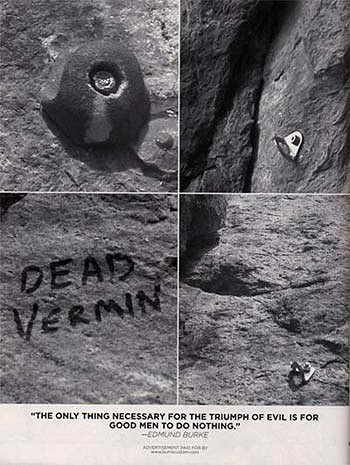
One interesting development, related to headpointing, is what has been termed as “boltpointing”.
This is where an existing bolted route is led without clipping the bolts using only natural gear after working the route using the bolt protection. Canadian Sonnie Trotter used this technique to do a bolt free ascent of the East Face 5.13d (Fr 8b) of the Monkey Face at Smith Rock, actually placing all the gear on his lead. After this ascent he stated that “I think that 5.14 gear climbs should be the norm”. At California's' Donner Summit near Lake Tahoe, Alan Moore, after practice using the existing bolts, lead Father's Day on removable gear and ignoring the bolts which weighs in at a stout 5.14a.
These ascents do raise questions, such as why were these naturally protectable routes bolted in the first place? Or perhaps the darker conclusion of why not bolt up everything and if you want to lead without the bolts you just climb past them without clipping them. Will this trend reach across the pond to the UK? Perhaps it even started in the UK? Anthoine Le Menestrel soloed the sport route Revelations 8b at Raven Tor in 1985. Similarly Jimmy Jewell soloed the minimalist bolt route The Cad E5/6 at Gogarth. Both climbers left the bolts in (Jewel actually took it out for his ascent and replaced it after). Maybe the boltless ascent of Frankie Comes at Kilsney by Martin Berzins falls into this category, or John Dunne's ascent of the previously bolted Big Issue in Pembroke. Anyone for a bolt-free ascent of Malham's New Dawn?
On the other side of the dime, retrobolting is as much a problem in the US as it is in the UK. Ripping bolts out has been part of American climbing culture for decades and has involved fisticuffs between climbers in Yosemite parking lots and legal action between climbers in Boulder, Colorado. One novel approach that attempts to stem the tide of bad ethics recently was an advert placed by Washington State based climber Dane Burns in Rock and Ice magazine, showcasing destructive acts at his local cliff, including bolt-on-holds, chipped holds, painted graffiti, retrobolts and bolts next to cracks.
Here's an “Only in America” story. Well maybe. Jared Ogden and Ryan Nelson made an almost “free” ascent of the 14 pitch Hallucinogen Wall in the Black Canyon of the Gunnison, Colorado. Amongst bold 5.13 pitches protected by fixed copperheads they also climbed one un-free-able A5 hooking pitch using ice axes whilst wearing rock shoes, grading it D10+. Ogden believes that this tactic of "free climbing" using ice axes on dry rock will, “open new doors to the future of big-wall free climbing.” Many of course, including Alex Huber, hope not and it has been seen by some as a cheap publicity stunt, albeit a novel one, that if adopted will destroy and vandalize the true free climbing potential of big walls.
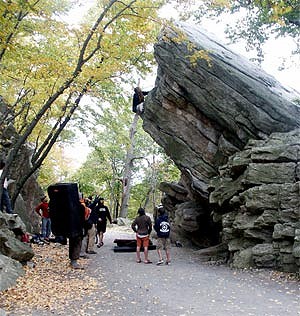
AN URBAN MYTH?
Amongst all this “traditional” and novel climbing action, bouldering, sport climbing and competition climbing are still very strong and those who limit themselves to such disciplines now have their own magazine devoted to these “urban” pursuits. Urban Climber Magazine, edited by Washington DC - based climber Matt Burbach, is printed in the UK and owned by a London-based publishing outfit, called Permanent Publishing, in conjunction with Skram Media (also UK owned) both of whom are involved in publishing “alternative sports” magazines covering snowboarding, skateboarding, surfing, BMX and kite surfing.
So wassup? Is Urban Climber magazine (UCM) any good?
It is, it's glossy, full-color, well-designed, well written and edited. It is aimed at some 8 million urban climbers (figure from the Sporting Goods Manufacturers Association) who have recently emerged from the 900 rock gyms in the US. These climbers are urban, hip, they sport climb, boulder and they compete in competitions and, as oldster Chris Grover states in a feature called Homage, “the urban climber is the first (and largest) population coming onto the scene with little direct influence from climbing's pre-existing landscape and culture”, or, as the young graffiti artist and climber Joe Kinder says about climbing's past traditions in a profile by Pete Ward, “it's just not relevant to what I do day to day”.
A couple of urban climbing destinations, Fontainebleau in France and New York City, are profiled. Joe Lurato, the butch cover-boy of this issue, and his crew visit Fontainebleau and discover the magic of the forest, the wisdom of Jo Montchausse, the rain, and that it's the climbing not the grade that really counts. The Gunks are profiled as perhaps the ultimate rural retreat for the urban climber - both young and old, trad and boulderers migrate there from nearby New York City each spring and autumn weekend.
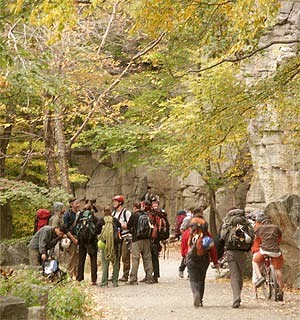
The urban is celebrated but there is some migration from this theme. Matt Stark in a department called “Finish Hold” on page 114 says, “We have substituted our outdoor pursuits with sterile and inadequate replacements. I ride a stationary bicycle. I run on a treadmill. And I climb on plastic holds....indoors”. Come on Matt, stick to the message, aren't you meant to be celebrating the urban experience, not moaning about it? Also contrary to this urban theme is a profile of the young tradster and all-round rural climber Tommy Caldwell who recently completed the first-free ascent of El Capitan's Dihedral Wall in Yosemite; his third free El Cap route.
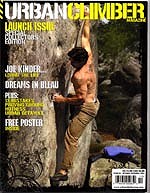
Urban Climber magazine seems to be targeted at 15 to late 20 something climbers and it certainly has a fresh and relevant voice that speaks directly to them. But will this demographic be able to sustain its own magazine? Rock and Ice magazine has recently improved dramatically, and Climbing magazine is back on track after some personal changes (Most of the staff of Climbing migrated to Rock and Ice magazine after Duane Raleigh, publisher of Climbing at the time, bought Rock and Ice magazine). The magazine business is notoriously cut-throat and Urban Climber magazine faces big challenges in its crucial first year.
Urban Climber Magazine is available from www.urbanclimbermag.com and if in the US from your local newsstand. It costs $4.99 (you get a free poster with this first issue and a free T-shirt and bouldering DVD if you subscribe for 12 months) and runs to 114 pages.
And now for something completely different.

CRAG SPOTLIGHT - Rock City - Bouldering In Kansas
With most American climbers living in urban areas and often having long distances to drive to their “local” crag we must thank the industrial-military complex and low taxes for such cheap gas (petrol), currently topping a ghastly $2 a gallon plus in some places compared to the Europeans who are currently paying $6 a gallon.
One crag hardly anyone drives to, but quite often drives by, is Rock City smack bang in the middle of the wheat fields of Kansas. The rock here is world-class but alas it is not extensive or it would have seen a Bishop bouldering-type marketing campaign long ago. But it is worth a stop if you are driving back east from the west to visit relatives, or driving back west to climb. The rock is a fine-grained Dakota sandstone formed into almost perfectly spherical orbs (or as my son described them “giant bowling balls”). They are called concretions by geologists, the largest in the world (not sure if that is 'world' as in USA world or global world) and were formed millions of years ago when Kansas was covered by an inland sea and grains of sand were cemented together by calcium carbonate forming large house-sized spheres. Before they could get any bigger, the sea dried up, the land lowered and non-cemented sand was eroded away by the elements leaving the Rock City bowling balls which sit on a knoll surrounded by typical Kansas fields of amber waves of grain. The climbing is good and there are around 50 or so problems and variations that range from kid-easy to tweaky desperates, all with nice grassy landings. Don't forget to put a donation in the box to help a local non-profit look after this unique area. How do you get there? Put on your ruby slippers and follow the yellow brick road of course Dorothy. But if you don't want to see the wonderful wizard of Oz, get to Salina, which is near-as-darn-it in the center of Kansas on Interstate 70 and drive north 16 miles on the Route 135, then west through Minneapolis and follow signs for Rock City.




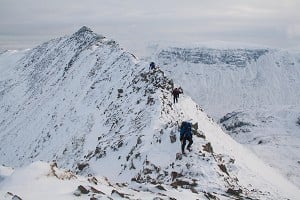
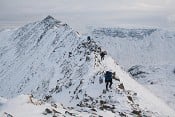
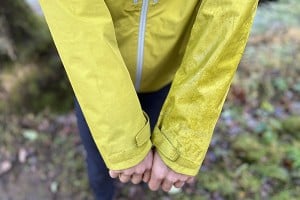
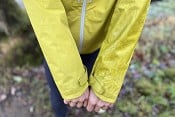








Comments